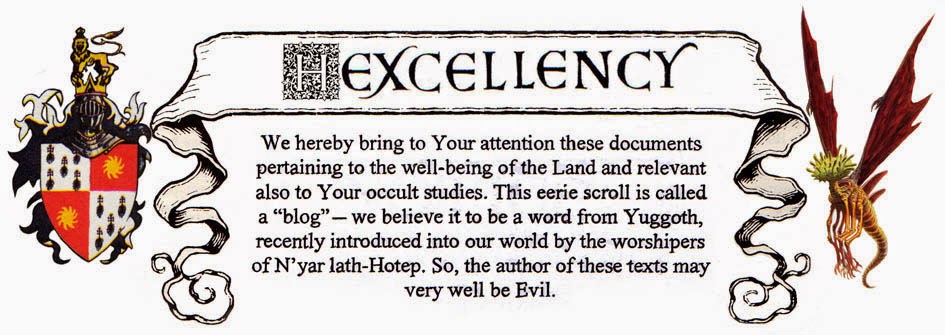With every year that passes, beholders are getting
angrier.
The beholder shown on the cover of 1975’s
Greyhawk
was just a smooth ball of baleful eyes floating around,
expressionless. A wider, more distinct mouth was added in 1977’s
Monster Manual,
with silly grin and pointy teeth. Obviously, the wider mouth was put
there to enhance facial expression. One central eye and a small
piehole doesn’t allow for a very wide range. It’s a one-eyed fish
kind of situation.
With a wider mouth, you’ve got more options. The
1977 beholder seemed happy enough – and why would any
beholder be unhappy? I’d certainly have a silly grin on my face
24/7 if I was lucky enough to fly and have a disintegration
ray
and a charm person ray!
What I call the “unifrown”
came along seven years later, in 1984: it was a stroke of genius by
illustrator Steve Bisset.
With both the wide mouth and the unifrown now in
place, beholders could express almost any emotion they wanted – but
they only became angrier and angrier. Why is that? I’ve always
thought the Greyhawk
beholder was eerily frightening with its blank stare and fishlike
mien. And the Monster Manual
beholder was creepy because
of the aforementioned grin. “Look at that merry psycho sphere of
evil!”
The modern beholder, that lick-spittle ball of
spikes and fury, is a little over the top for me. Why are they so
angry all the time? Hey, Eye Tyrants, relax! You guys are way up
there with the liches and red dragons. Chill out, will ya?
There really isn’t much to go on in the 1983 article The Ecology
of the Beholder. It reads more like a chapter in a novel about a
boy who is probably going to become a paladin. The article only tells
us that the beholder’s flight isn’t magical in nature, and that
every beholder spits 1 to 4 eggs per year from its mouth. So, a
dispel magic or an antimagic field cannot cause a beholder to
drop down. Nothing would be more pathetic than a helpless beholder
rolling on the floor, unable to fly. And beholder reproduction also
seemed absolutely ludicrous. Imagine, if you will, those mating
positions...
All beholders spit
eggs from their mouth.
No sexual organs – maybe that’s why they’re so angry all
the time.
But let us dig a little deeper here. For instance: skull, or no
skull? One could argue that the chitinous plates covering a
beholder’s body are the only skeleton – or, in this case,
exoskeleton – they need. But then again, they’ve got a wide maw
with teeth, right? Teeth means jawbone, and jawbone means
skeleton. Here is something Ed Greenwood and Roger E. Moore should
have tackled.
What would a beholder’s skull look like? It would need ten small
holes for the eyestalk muscles and nerves to pass through, and it
also implies that there’s an “open”
spot down under, because if it was just solid bone all around, the
articulation wouldn’t be able to open.
A
beholder’s stomach has to be located above its throat. When
a beholder swallows its food, it swallows up into its stomach.
(Yes, read that again.) The stomach connects to the intestines, and
the intestines eventually circle all the way back to the underside of
the spherical body, where the anus ought to be found.
Older beholders would also have a sort of bulge underneath.
With time, the inner organs would naturally begin to droop through
the mandible aperture. An ancient beholder would look something like
this:
That’ll make ‘em angrier still.
I
guess I’m not helping much here.
Who
Invented the Beholder?
Allow me to reiterate something I have already touched upon in this
blog. Beholders, in all likelihood, come from the fabled Tekumel
“Eyes.”
Professor M.A.R. Barker first published his Empire
of the Petal Throne role-playing game
in 1974, describing in it an array of 33 ancient technological
devices looking like eyes, each one capable of shooting a ray of
power in the direction it is pointed in. The “Excellent
Ruby Eye”
would cast the equivalent of a hold
person or hold
monster spell.
The “Splendid
Eye of Krá
the Mighty”
would shoot a powerful telekinesis
ray. The “Eye
of Frigid Breath”
generated a pretty straightforward death
ray
(i.e. Save or die).
This book was self-published one year before the
Greyhawk
supplement on the cover of which we can see the very first,
expressionless beholder.
What I think has happened is rather simple. Gary
Gygax read about the Professor’s “Eyes”
and thought, “How could these different shooting rays be thrown
against a D&D
adventuring party, but without the constant need of non-player
characters to hold and operate the devices?”
And the answer
was, of course, take a bunch of “Eyes,” make them fly, and give
them a will of their own. Theron Kuntz wrote that up, since Gary
himself was so busy. After that, bundling up these eyes together was
just a formality!
I’m not
saying Gygax and Kuntz plagiarized the Professor. You have to put
yourself back in the 1974 frame of mind: they all
borrowed from each other. Tekumel’s
Ahoggyá is an obvious borrowing of Ashton Smith’s Tsathoggua –
and the Ahoggyá itself inspired AD&D’s
Xorn. You get the gist.
Canonically
speaking, Empire
of the Petal Throne
is a First Edition D&D
setting, so why wouldn’t the Eyes have some obscure, arcane link to
the beholders, and why wouldn’t the Xorns be distant “elemental”
cousins of the Ahoggyá? I’m sure there is a way to link
pre-béthorm
Tekumel to prehistoric Oerth via Spelljammer.
You just need the lawyers to agree – and why the hell wouldn’t
they? Just imagine the galaxy-spanning science-fantasy campaign!
There must be
a Beholder homeworld out there somewhere, just like there’s
definitely an Illithid homeworld. Let it be said that I, for one,
would buy this book in a heartbeat.







